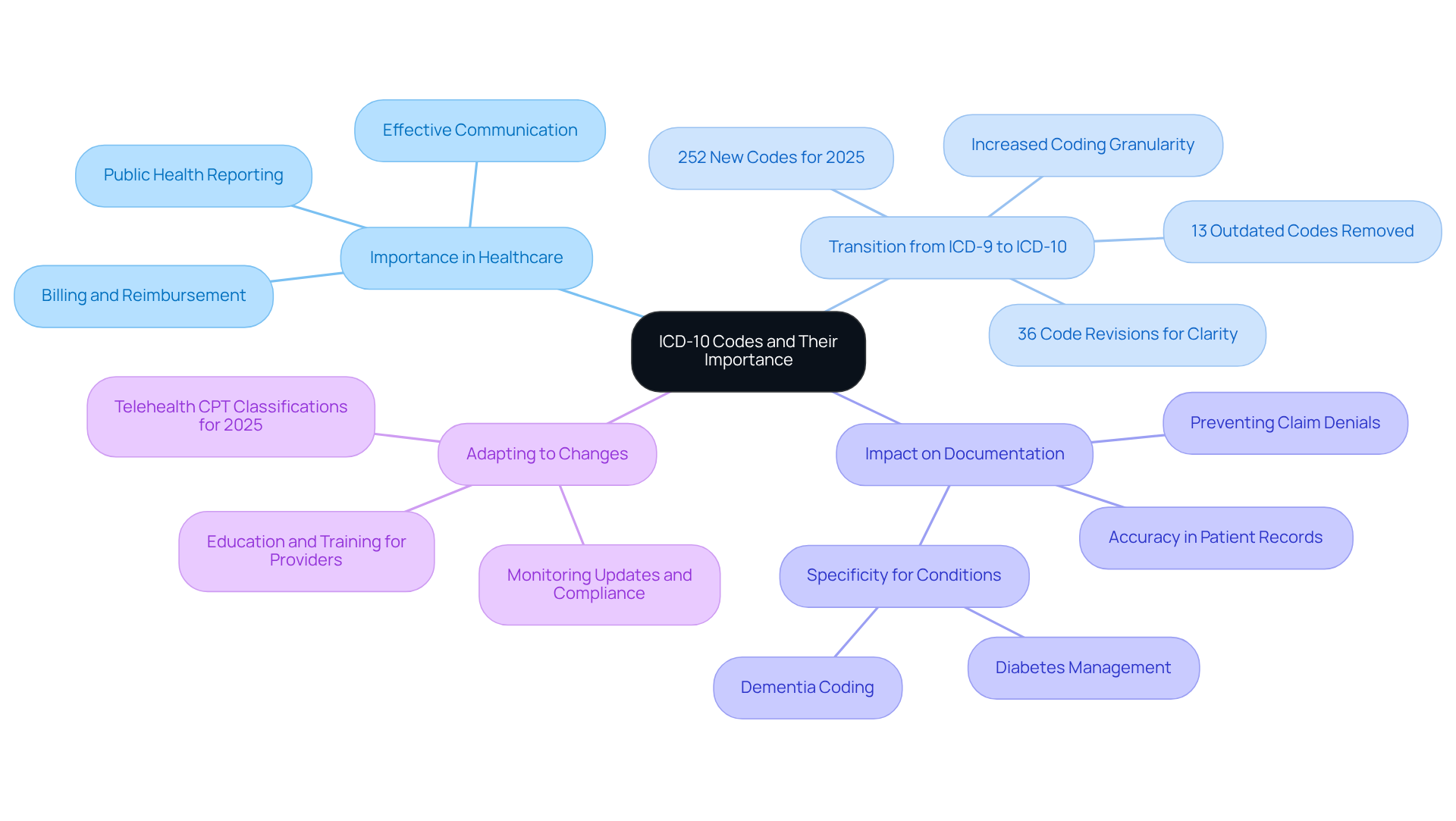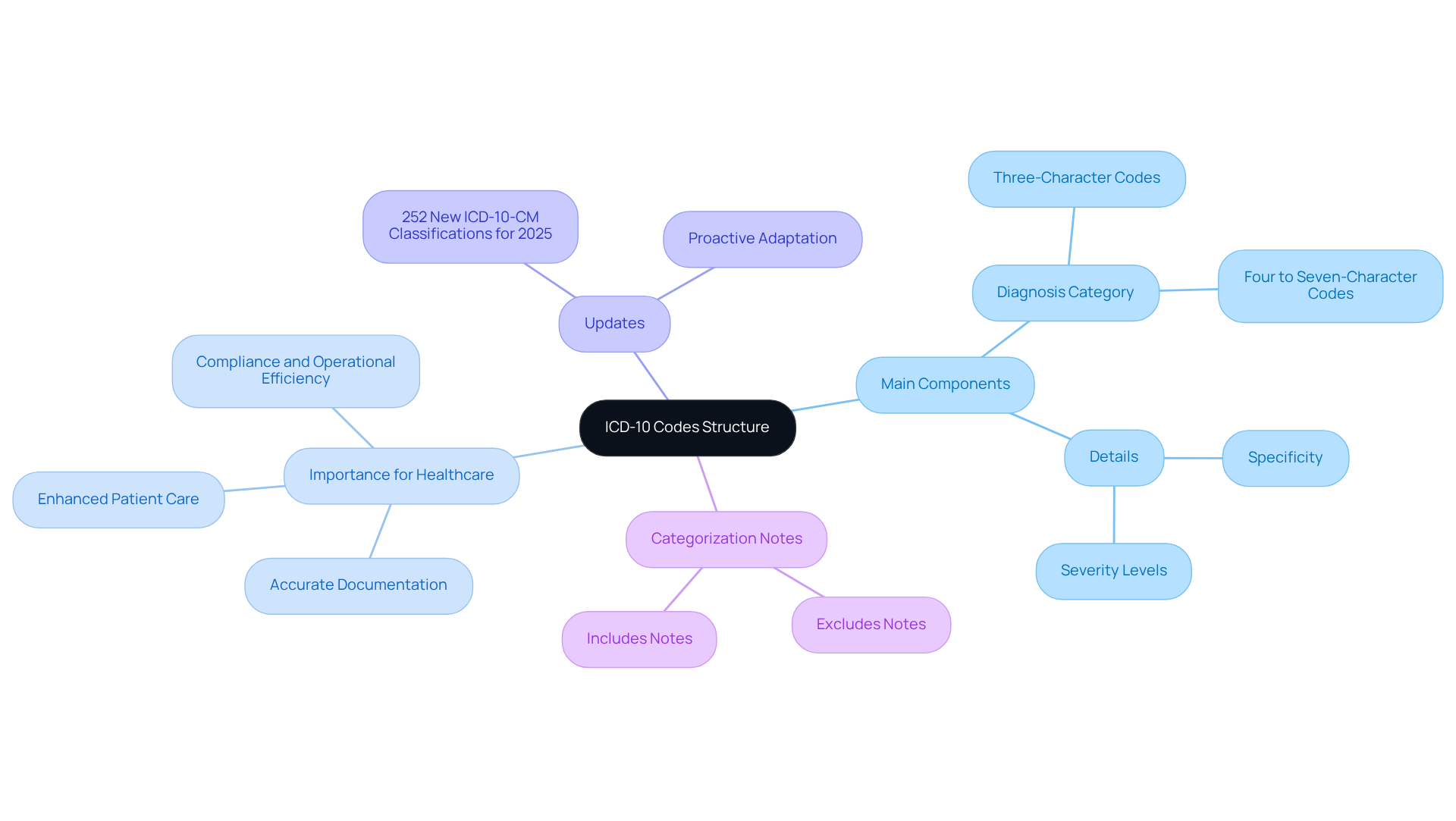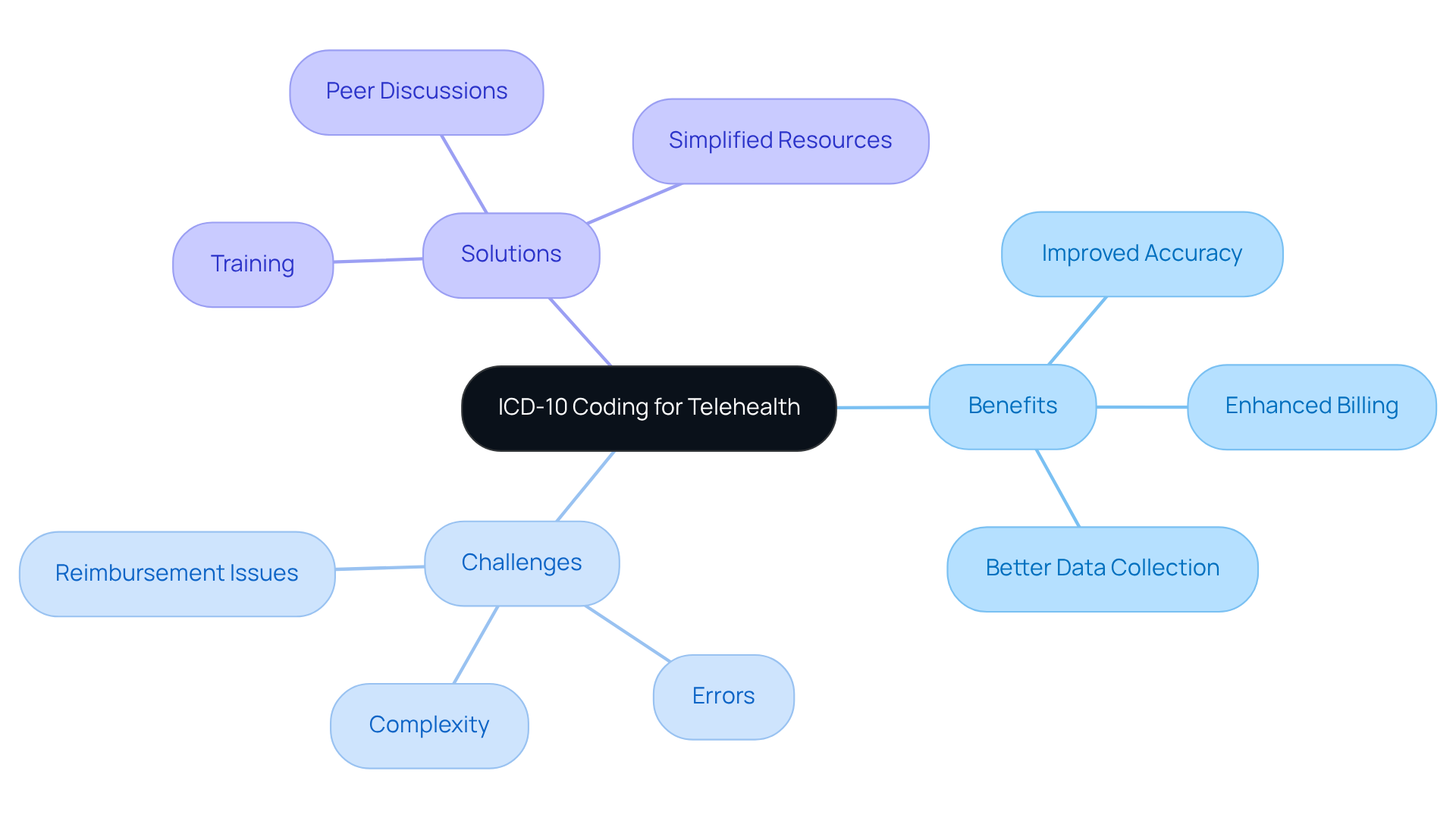Overview
Understanding ICD-10 codes for telehealth visits is crucial for healthcare providers, especially in today’s fast-paced environment. Have you ever felt overwhelmed by the complexities of billing and coding? You’re not alone. Many healthcare professionals face emotional challenges as they navigate these intricate systems, which can impact the quality of patient care.
Accurate coding is not just about compliance; it’s about enhancing patient care. When coding is precise, it leads to better diagnosis documentation and improves reimbursement processes. This means less time spent on administrative tasks and more time dedicated to what truly matters—your patients. Imagine a world where you can focus on providing care without the constant worry of billing issues.
Here are some key benefits of understanding ICD-10 codes:
- Improved reimbursement processes: Ensures you receive the payment you deserve for your services.
- Reduced administrative burdens: Frees up your time to focus on patient care.
- Enhanced diagnosis documentation: Leads to better patient outcomes and satisfaction.
By embracing these coding practices, you’re not just complying with healthcare standards; you’re fostering a more efficient healthcare environment. So, how can you start this journey? Consider seeking out resources or training that can help you master ICD-10 codes. Together, we can navigate these challenges and improve the care we provide.
Introduction
In the caring realm of healthcare, providers often grapple with emotional challenges that can weigh heavily on their ability to deliver quality care. The intricate world of healthcare relies on standardized coding systems, with the International Classification of Diseases, Tenth Revision (ICD-10) playing a pivotal role. These codes are not just alphanumeric identifiers; they are essential tools that enhance billing accuracy and streamline communication among providers. However, as telehealth evolves, the challenge of accurately applying these codes during virtual consultations becomes a pressing concern.
How can healthcare providers navigate this complexity while ensuring they deliver the highest quality of care? The administrative burdens can feel overwhelming, impacting not just the workflow but also the patient experience. When providers are bogged down by coding issues, it can detract from the time and attention they wish to devote to their patients.
To address these challenges, consider the following solutions:
- Invest in training for staff to ensure they are well-versed in coding practices.
- Utilize technology that simplifies the coding process and reduces errors.
- Foster open communication among team members to share insights and strategies.
By embracing these strategies, healthcare providers can enhance their efficiency and, ultimately, the quality of care they offer. It’s essential to remember that accurate coding not only supports billing but also elevates patient care. Let’s work together to navigate these complexities and ensure that every patient receives the attention they deserve.
Define ICD-10 Codes and Their Importance in Healthcare
The International Classification of Diseases, Tenth Revision, serves as a vital tool for healthcare professionals, providing a standardized collection of identifiers to categorize and denote diagnoses, symptoms, and procedures. But have you ever considered how these identifiers impact your daily practice? They’re not just codes; they’re essential for precise billing and reimbursement, effective communication among providers, and crucial public health reporting and research. By enhancing the precision of classification systems, we can monitor health trends and outcomes more effectively, ultimately improving patient care and safety.
For example, the transition from ICD-9 to ICD-10 introduced a more detailed coding system, allowing for a richer granularity of health data. This change is significant, especially as we look ahead to the updates in the ICD-10-CM code book, effective October 1, 2024. With 252 new codes, 36 revisions for clarity, and 13 outdated codes removed, this granularity empowers healthcare providers to capture complex cases more accurately. As RoseZetta Lima wisely noted, "Precise, current medical records guarantee that patient care plans represent their most recent health issues." This highlights the importance of staying informed about documentation modifications.
Moreover, the application of specific classifications for conditions like diabetes and dementia has greatly improved documentation accuracy. This allows for tailored treatment plans that meet the unique needs of each patient. Did you know that over 30% of claims are rejected due to erroneous entries? This statistic underscores the necessity for healthcare professionals to prioritize accuracy to prevent revenue loss and ensure quality care.
Understanding the categories for behavioral disturbances in dementia and documenting the relationship between etiology and manifestation are also crucial for effective patient management. As our healthcare landscape evolves, the implications of new telehealth CPT classifications for 2025 further emphasize the need for practitioners to adapt to these changes. By doing so, we can enhance patient care and safety, ensuring that our practices remain responsive to the needs of those we serve.
In summary, staying updated on classification changes is not just about compliance; it’s about fostering a supportive environment for both healthcare providers and patients. Let’s commit to embracing these updates together, ensuring that our documentation reflects the highest standards of care.

Explore the Role of ICD-10 Codes in Telehealth Visits
In the world of telehealth consultations, healthcare providers often face emotional challenges. The pressure to accurately record and bill for services, particularly the ICD 10 code for telehealth visit, can feel overwhelming, especially as telehealth expands in the wake of the pandemic. Have you ever felt the weight of ensuring that every detail is captured correctly?
Diagnostic classifications are essential in this process. They help providers represent a patient’s condition as assessed during virtual consultations. For instance, mental health regulations have seen increased use in telehealth, which not only facilitates proper billing through the ICD 10 code for telehealth visit but also ensures that patients receive the care they need. This is crucial for maintaining trust and continuity in patient-provider relationships.
Moreover, the use of the ICD 10 code for telehealth visit enhances the overall efficiency of the healthcare system. It streamlines processes, allowing providers to focus more on what truly matters: patient care. By ensuring accurate coding, we can alleviate some of the administrative burdens that often distract from the core mission of healthcare.
Key Benefits of Accurate Diagnostic Classifications:
- Ensures proper billing and reimbursement.
- Facilitates continuity of care for patients.
- Reduces administrative burdens on healthcare providers.
As we navigate this evolving landscape, let’s remember the importance of supporting one another. By prioritizing accurate diagnostic classifications, we can foster a more compassionate and efficient healthcare environment. Together, we can make a difference in the lives of our patients.

Break Down the Structure and Components of ICD-10 Codes
ICD-10 identifiers can feel overwhelming, can’t they? These alphanumeric codes range from three to seven characters, starting with a letter followed by numbers. The first three characters indicate the diagnosis category, while the additional characters provide specific details about the condition. For example, 'E11' refers to Type 2 diabetes mellitus, and adding more characters can clarify any complications or manifestations. This structured approach is crucial for accurately representing a patient’s health status, which is vital for effective treatment planning and billing.
Understanding this framework is essential for healthcare professionals. It ensures that documentation is both correct and thorough, ultimately benefiting patient care. With 252 new ICD-10-CM classifications introduced for 2025, it’s important for practitioners to recognize how these updates can improve compliance and operational efficiency. As Emily Montemayor, Medical Coding Support Manager, pointed out, adapting proactively to these changes can enhance compliance and reduce denials, which supports better patient care.
Moreover, the use of 'Includes' and 'Excludes' notes in the classification system is vital for precise categorization and adherence to guidelines. This guarantees that the codes chosen accurately reflect the recorded conditions. By grasping these conventions, along with specific programming guidelines for conditions like dementia and substance use disorders, healthcare professionals can enhance their practices and improve overall service delivery.
So, how can you ensure you’re up to date with these changes? Consider engaging with training sessions or resources that focus on the latest updates. Embracing these tools not only supports your compliance efforts but also enriches the care you provide to your patients.

Analyze the Benefits and Challenges of ICD-10 Coding for Telehealth
For many healthcare providers, implementing the ICD 10 code for telehealth visit can feel overwhelming. The emotional toll of navigating complex coding systems while striving to provide the best patient care is significant. Have you ever felt the pressure of ensuring accurate diagnosis documentation while managing billing processes? You're not alone in this struggle.
The substantial benefits of using the ICD 10 code for telehealth visit are significant. Improved accuracy in diagnosis documentation, enhanced billing processes, and better data collection for health trends can lead to more effective patient care. However, these advantages of the ICD 10 code for telehealth visit come with challenges. The complexity of the programming system can lead to errors if not fully understood, and ensuring that the ICD 10 code for telehealth visit is accurately recorded during virtual consultations can be daunting. This uncertainty can impact reimbursement, adding to the stress.
To navigate these challenges, training and ongoing education in the ICD 10 code for telehealth visit are essential. By investing in your knowledge, you can overcome these hurdles and fully leverage the benefits of telehealth. Here are some key solutions to consider:
- Participate in training sessions to deepen your understanding of ICD-10.
- Engage in peer discussions to share experiences and strategies.
- Utilize resources that simplify the coding process.
By embracing these solutions, you can enhance your confidence in coding and improve patient care. Remember, you’re not alone in this journey. Together, we can work towards a more streamlined and effective telehealth experience.

Conclusion
The significance of ICD-10 codes in telehealth is profound. These codes are essential for accurate documentation, billing, and patient care, allowing healthcare providers to communicate diagnoses and treatment plans effectively. As telehealth continues to grow, understanding and implementing these codes is crucial for delivering high-quality care.
Healthcare providers often face emotional challenges when navigating the complexities of coding. The administrative burdens can impact patient care, leading to frustration and stress. How can we alleviate these pressures? By focusing on precise coding, we can enhance billing and reimbursement processes, ultimately improving patient care.
The introduction of new codes in 2025 highlights the importance of ongoing education and adaptation. This is not just about compliance; it’s about creating a healthcare environment that prioritizes patient safety and quality of care. Investing in training and resources can help providers overcome the challenges posed by these coding systems.
Here are some key solutions to consider:
- Invest in training to ensure staff are well-versed in ICD-10 coding.
- Utilize resources that simplify the coding process and enhance understanding.
- Foster a supportive environment where questions and discussions about coding are encouraged.
Embracing the intricacies of ICD-10 coding is a collective journey. By working together, we can lead to significant improvements in telehealth services, benefiting both providers and patients alike. Let’s commit to mastering these codes, ensuring our practices remain efficient and responsive to patient needs.




